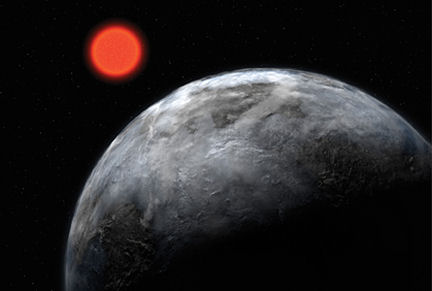An Earthlike Planet
Astronomers have discovered an Earthlike planet that could have liquid water, and perhaps life, on its surface.
Share this:
- Share via email (Opens in new window) Email
- Click to share on Facebook (Opens in new window) Facebook
- Click to share on X (Opens in new window) X
- Click to share on Pinterest (Opens in new window) Pinterest
- Click to share on Reddit (Opens in new window) Reddit
- Share to Google Classroom (Opens in new window) Google Classroom
- Click to print (Opens in new window) Print
By J. L. Pegg
Astronomers don’t know whether life exists on other planets. But if it does, it’s most likely to be found on a planet that has liquid water. Water, after all, is essential to life on Earth.
Now, astronomers have discovered a distant planet that could have water. That, in turn, raises the possibility of extraterrestrial life.
 |
|
This drawing shows the newfound planet, which orbits the red dwarf star Gliese 581. On the planet’s surface, water would probably be liquid.
|
| European Southern Observatory |
The planet isn’t in our solar system, so it’s called an extrasolar planet. It orbits a star called Gliese 581, which is about 116 trillion miles from Earth.
Astronomers have found other extrasolar planets, but none seems habitable. Most are giant balls of gas. Many are so close to their fiery stars that water on them would boil away; others are so distant that water would freeze.
The new extrasolar planet is too small for telescopes to take a picture of it. But astronomers have figured out that, like Earth, it has a solid surface. Equally important is its temperature. It’s located in what astronomers call the “Goldilocks Zone”—a distance from its star that makes the planet neither too hot nor too cold, but just right for water to exist as a liquid.
Because they couldn’t see the planet, astronomers led by Stephane Udry of the Geneva Observatory, in Switzerland, looked to the star for clues. They studied Gliese 581 to see whether it was “wobbling.” The weak gravitational pull of a planet orbiting a star can cause the star to move back and forth.
Using an instrument called a spectrograph, Udry’s team measured the wobble of Gliese 581 by recording the pattern of changes in its light.
The astronomers’ measurements revealed a lot about the new planet. For example, it’s about five times as heavy as Earth, and it orbits its star every 13 days.
It’s also closer to its star than Earth is to the sun. But Gliese 581 is a red dwarf, which is a kind of star that’s cooler than our sun. So, the temperature on the planet is probably about the same as temperatures are on Earth.—J.L. Pegg
Going Deeper:
Cowen, Ron. 2007. In the zone: Extrasolar planet with the potential for life. Science News 171(April 28):259. Available at http://www.sciencenews.org/articles/20070428/fob1.asp .
Jaffe, Eric. 2006. A puffy planetary puzzle. Science News for Kids (Sept. 20). Available at http://www.sciencenewsforkids.org/articles/20060920/Note3.asp .
Sohn, Emily. 2005. Cousin Earth. Science News for Kids (June 29). Available at http://www.sciencenewsforkids.org/articles/20050629/Note2.asp .
______. 2004. Planet hunters nab three more. Science News for Kids (Sept. 8). Available at
http://www.sciencenewsforkids.org/articles/20040908/Note2.asp .







